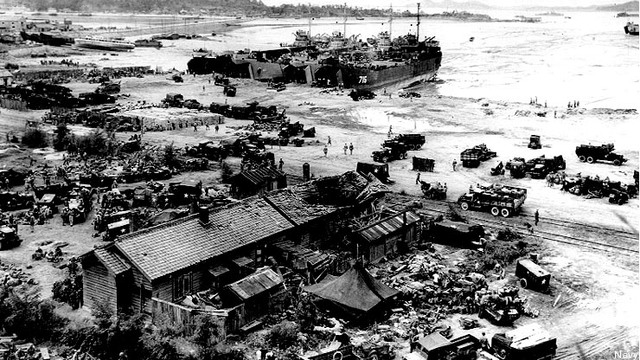Army Scrambles To Play Catch-Up On AirSea Battle
Posted on

US ARMY WAR COLLEGE: While fictional wars set in the world of 2020 rage on the floors below, up on the third floor of the War College, Army generals wrestled with the budget battles of today. Topic number one: how to beat – or join – the bandwagon that is AirSea Battle.
“You’re a couple of years behind,” warned one civilian. The other services have nominated over a hundred ideas for research funding, based on what they think they’ll need to conduct AirSea Battle, the Air Force and Navy concept for projecting US power overseas in the face of increasingly sophisticated defenses. The Army has nominated none. “While we are debating,” he went on, “the train is leaving the station.”
There are other topics on the table for this “Strategic Working Group,” made up of dozens of senior Army officers, liaisons from foreign militaries, and civilian experts from across the Defense Department and the thinktank world: cyber warfare, Special Forces, the human aspects of armed conflict, military presence overseas, and the strategic environment writ large. But yesterday afternoon, when Breaking Defense was allowed to sit in – on the condition that we did not name any participants – no issue aroused more passion and anxiety than AirSea Battle. The collective attitude was an intriguing mix of envy and skepticism: political-bureaucratic envy that the other services have found such an apparently successful way of securing, even enlarging, their share of a shrinking budget; combined with professional military skepticism that AirSea Battle actually solves the strategic problem.
The objective isn’t merely to find an Army niche in AirSea Battle, said the two-star general moderating the meeting. It’s to find – and sell – the things the Army does that AirSea Battle does not address.
To skeptics, AirSea Battle envisions a pristine duel with precision weapons fired at long range from air and sea. That’s the kind of high-tech warfare where America historically has done well for decades, instead of the messy knife-fights on the ground that have bedeviled the US from Korea to Vietnam to Iraq and Afghanistan. With AirSea Battle, said one attendee, “we’re fighting the conflict we want to fight instead of the conflict that might be presented to us.”
Okay, replied the moderator, but “do we say that out loud as an army?”
Many in this working group, at the wargame downstairs, and even outside the Army see AirSea Battle as only a partial solution, one that addresses how to get US forces into a region via planes and ships but then stops, just when the battle’s beginning for the Army and Marines going ashore. They have some support in inter-service doctrine. Officially, AirSea Battle is merely a sub-concept nested under the clunkily named “Joint Operational Access Concept” (JOAC). JOAC’s second and theoretically co-equal sub-concept is the Army and Marine Corps-driven “Joint Concept for Entry Operations,” which picks up where AirSea stops by describing how US forces will project power inland. That Army and Marine approach to “entry operations” will be further refined this summer in a classified wargame to test an approach called “Gaining And Maintaining Access,” which one Army officer in the War College discussion bluntly called “our rejoinder, with the Marine Corps,” to AirSea Battle.
But there’s a problem with this counter-argument to AirSea Battle, however, warned another Army officer: It boils down to saying “we can invade a country and we can really stay there for a long time,” which makes a terrible “bumper sticker” for the Army – there was a round of rueful laughter at this point – because it’s something nobody wants to do and no American policymaker will trumpet. Sometimes, even most of the time, domestic politics, international opinion, or even sound military strategy will limit American military action to long-range strikes, without troops on the ground, as it was in Libya last year or in Kosovo in 1999.
A second problem with “entry operations” as a selling point for the Army and Marines is that “we’ve allowed this capacity to atrophy,” added one civilian participant. In 1950, during the Korean War, we put ashore more than two divisions at Inchon (pictured). Today the Marines can land less than two brigades by sea, with the Army adding an airborne brigade by parachute; a landing capacity called “Joint Logistics Over The Shore” might add another Army brigade, but only once the shooting stops. In the wargame downstairs, such a small landing force got badly bloodied.
That capacity to go ashore and stay ashore while fighting is a crucial one for the Army and Marine Corps to retain, participants generally agreed. But, the consensus suggested, the area where the ground forces will be able to contribute more often and at less cost is before the conflict even starts: sending advisors, conducting international exercises, and generally building relationships around the world — a key part of the new national strategy. At best, visibly supporting friends and allies this way will deter a war altogether. At worst, if war does come – and it always comes somewhere, sometime – building up friendly countries will make them not only stronger but also more willing to provide the bases that the Air Force and Navy need to conduct AirSea Battle. In other words, while the Army and Marines do need to think about how they pick up the fight after the AirSea Battle stops, their most valuable contribution may come before it even begins.
Subscribe to our newsletter
Promotions, new products and sales. Directly to your inbox.
